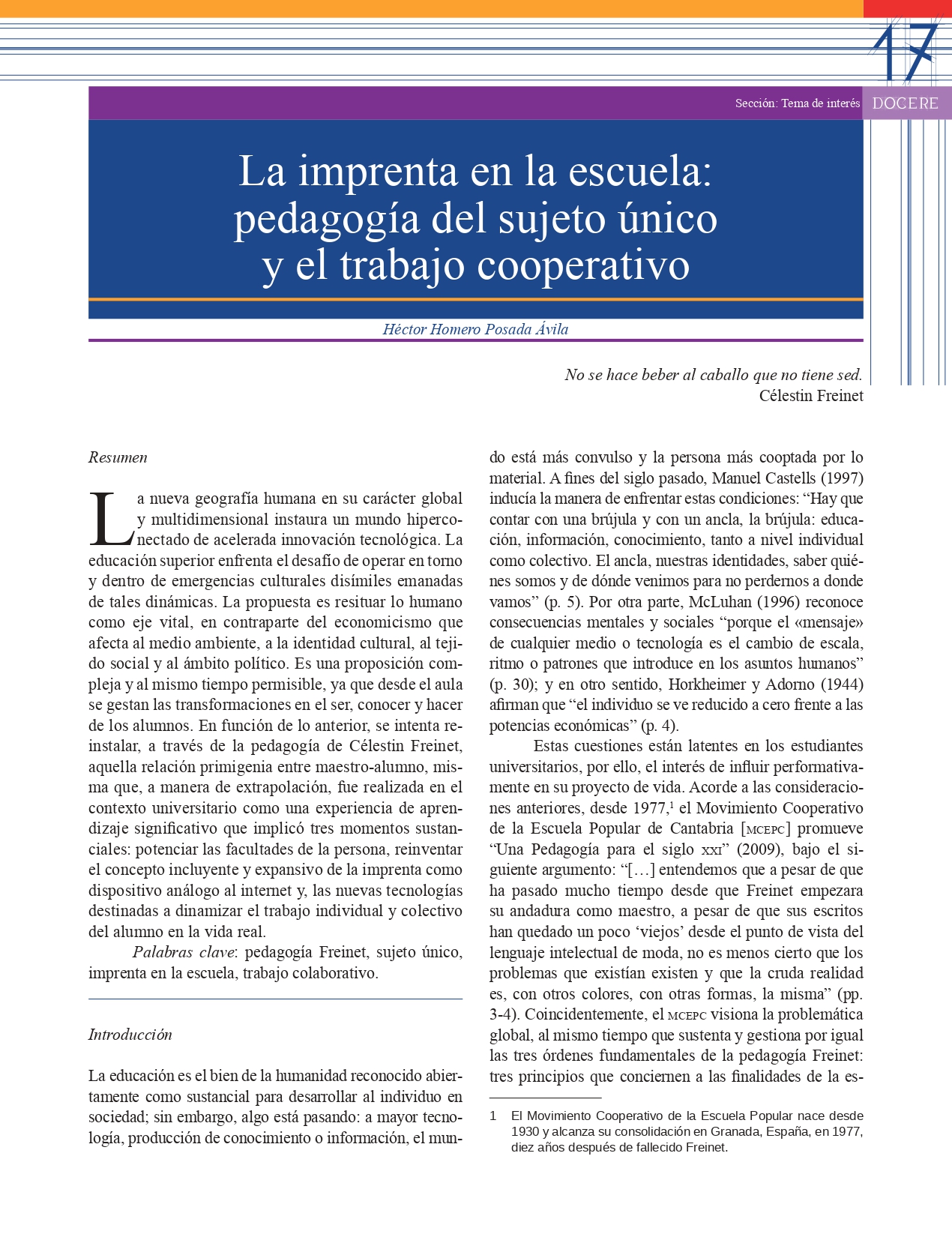Printing Press in School: Pedagogy of the Unique Subject and Collaborative Work
DOI:
https://doi.org/10.33064/2018docere191725Keywords:
Freinet pedagogy, unique subject, printing press in school, collaborative workAbstract
The new human geography in its global and multidimensional character establishes a hyperconnected world of accelerated technological innovation. Higher education faces the challenge of operating within dissimilar cultural emergencies of those dynamics. The proposal is to reframe the human aspect as a vital axis in contrast to the economic determinism that affects the environment, cultural identity, social fabric, and the political aspect. This is a complex and at the same time permissible proposition as transformations in the students’ being, knowing, and doing are cultivated from the classroom. Based on the above, the intention is to reestablish, through the Célestin Freinet pedagogy, the original student-teacher relationship, which, by way of extrapolation, was applied in the university context as a significant learning experience involving three substantial moments: enhancing the individual’s faculties, reinventing the inclusive and expansive concept of printing as an analog gadget to the internet, and having new technologies aimed to dynamize the student’ individual and collaborative work in real life.
Translated by Adán Israel Vázquez Alba.
Downloads
References
Castells, M. (1997). La era de la información: economía, sociedad y cultura. La Sociedad Red. Volumen I. Madrid: Alianza Editorial, S. A.
Corti (Prod.) y Chanois, J. (Dir.). (1949). L’école buissonnière. [Cinta cinematográfica]. Francia: Union Generale Cinematographique.
Freinet, C. (1995). Parábolas para una Pedagogía Popular. España: Planeta-Agostini.
Horkheimer, M. y Adorno, T. (1944). Dialéctica del iluminismo. Recuperado de: https://bit.ly/2GoNLYn.
MCEP de Cantabria (2009). Frainet. Una pedagogía para el siglo XXI. Santader: Universidad de Cantabria. Recuperado de: https://es.calameo.com/books/001885745f4cef4d0fe30.
MCEP de Madrid (1983). El Movimiento Cooperativo de la Escuela Popular. Vida Escolar, (2), 113-122.
McLuhan, M. (1996). Comprender los medios de comunicación. Las extensiones del ser humano. España: Ediciones Paidós Ibérica, S. A.
Peyronie, H. (2001). Pedagogía y emancipación. México: Siglo XXI Editores.
Posada, H. H. (2014). Collage y fotografía. Creación del periódico Dale Dale. [Figura 2]. s/a (s/f). Libro de la vida. La imprenta en la escuela de Freinet, en la escuela de Vence, Alpes Marítimos franceses, año de 1940. [Figura 1]. Recuperado de: https://bit.ly/2J64u4q.

Downloads
Published
How to Cite
Issue
Section
License
Esta obra está bajo una Licencia Creative Commons Atribución-NoComercial-CompartirIgual 4.0 Internacional.
El lector y/o usuario que utilice el material publicado en la revista DOCERE de la Universidad Autónoma de Aguascalientes, deberá en todos los casos: a) Reconocer la autoría del material utilizado, proporcionando un enlace a la licencia, además de indicar sí se han realizado cambios al material; b) Queda prohibido utilizar el material proveniente de la revista DOCERE, con finalidad comercial y, C) En los casos en los que se realice la remezcla, transformación o creación, a partir del material publicado de la revista DOCERE, se deberá dar reconocimiento de los derechos que correspondan a la Universidad Autónoma de Aguascalientes, en su carácter de titular de la materia protegible utilizada. En caso de infracción a lo antes dispuesto, el lector y/o usuario, se hará acreedor a las sanciones que establece la legislación de la materia.












